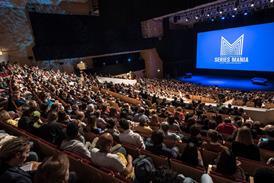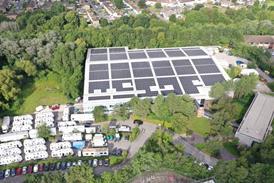For the Rugby World Cup kicking off in September, host broadcaster ITV will be rolling out a series ofinnovations in replay technology, camera positioning and fibre connectivity. Adrian Pennington reports


Since its inauguration in 1987, the Rugby World Cup (RWC) has become one of the most significant international sporting events. It is the third largest TV spectator sport after the Olympics and Fifa World Cup, boasting a global audience of 4.2billion.
“This year’s operation is on a much grander scale than any previous Rugby World Cup,” says World Rugby head of RWC Alan Gilpin.
The event will take place at stadiums across England and in Cardiff from 18 September to 31 October, with ITV acting as host broadcaster. It will air all 48 matches live from 13 stadiums, only four of which are recognised rugby grounds: Twickenham (London), the Millennium Stadium (Cardiff ), Sandy Park (Exeter) and Kingsholm (Gloucester). Others are football grounds, including Elland Road (Leeds), Ashton Gate (Bristol) and Old Trafford (Manchester).
ITV, which has covered the RWC since 1991, has been planning the event for more than three years. It is a massive logistical exercise for technical director Roger Pearce.
“Production is reasonably straightforward technically, but with 13 venues and up to four live matches on a single day, it is quite a task to manage the outside broadcast facilities,” he says.
Five OB trucks from Arena will provide all of ITV’s coverage. Eight scanners from CTV, NEP Visions and Telegenic will service the host feed, which will be routed to the Inter national Broadcast Centre (IBC) at IMG’s Stockley Park base. This will essentially be a switching centre that will route the multilateral feed from the venues onto Globecast’s worldwide satellite distribution network. IMG will also host live production of press conferences and the official ‘citing commissioners’ (independent officials).

Foreign-language graphics for French broadcasters TF1 and Canal+ will also be produced at the IBC because World Rugby insists that changes in graphics are monitored for consistency of branding.
“It’s a remote production in the sense that all the multi-language feeds are going to be triggered at the IBC,” says IMG senior vice-president and global director of engineering and technology David Shield. “This allows greater efficiency as they can be used for multiple games throughout the day.”
The match feeds will be recorded onto around 40 EVS XT3 servers, live logged on IP Director and sent to the RWC archive – managed by IMG and into which rights holders can dip to augment programming – and to Avid Isis for highlights production.
IMG will also produce matchday highlights, a weekly half-hour programme and daily digital highlights for internet and mobile.
The Tournament Information Service (TIS) provided by Opta will include a live data feed from each venue. This, in turn, will drive the host graphics machines supplied by Alston Elliot, which will be used to create graphical analysis such as heat maps. The TIS will also provide all commentary feeds into the IBC as voiceover IP, using systems from Riedel and BMCUK.
Perhaps surprisingly, no 4K will be captured during the tournament. “At the time we were agreeing the broadcast specs [four years ago], 4K was less prevalent than it is now so it was never scoped into what we were doing,” says Gilpin. “We’re not short of coverage in terms of HD cameras. We’ll review the position immediately after this World Cup as we begin planning for 2019 in Japan. We are driven by the desire of rights-holding broadcasters.”
SIS Live fibre network
SIS Live is providing ITV with all communications and live feeds for the six-week competition, including a return HD feed to the OBs on-site. It has plugged dedicated 1Gigabit fibre into each venue based on Net Insight’s Nimbra platform (pictured below) and is providing 10 single and three dual antenna uplink trucks, with more than 1,000 hours of satellite capacity, as a back-up.

At the four main venues (Millennium Stadium, Wembley, Olympic Park and Twickenham) SIS is also providing a third back-up in microwave links.
SIS purchased fibre connectivity for the tournament from Vodafone and will operate it as a managed network for ITV out of its operations centre at MediaCityUK in Salford.
Cameras: new angles
Coverage from different grounds will vary according to a seeding worked out by World Rugby and ITV. Games at Twickenham and Cardiff, for example, are categorised as A+ and will have the most camera positions. Matches at Milton Keynes or Brighton will have fewer bells and whistles, mainly because these football grounds do not have regular camera positions for rugby.
“A+ matches will have 37 or 38 cameras, including remotes in the dressing rooms and coaches’ boxes,” says ITV project director for multilateral Paul McNamara. “That’s excluding ITV’s separate on-field presentation and studio operation.”
One fresh innovation is a railcam that will run behind the posts at either end of the Twickenham pitch. “With a scrum on the 22 metre line, you have the option of looking head-on at rucks and mauls, all the pushing and shoving, rather than a conventional side-on view,” says McNamara. “It took a lot of persuasion and testing to get the RWC to agree because these positions are in the line of sight of spectators and press photographers.”
ITV has also put cameras into each corner flag “to give a wide angle of players diving into corners. It’s a fantastic effects shot.”
Match directors will also be able to cut to a ‘Ref Cam’ worn on the official’s chest. French broadcaster TF1 is offering an unedited stream of this with the referee’s in-game commentary (which will also be streamed to a mobile app by sponsor O2).

BSI and Vitec-owned Camera Corps are providing the specialist cameras, including Spidercam for overhead tracking shots of line-outs but excluding I-Movix Ultra motion cameras, which will be supplied by Editec.
“With all of these effects cameras, the key is timing,” says McNamara, who picked up a Bafta for Best Director of a Multi-Camera Programme in 2015 for his work on the FA Cup Final. “I’ll be telling all my directors not to overplay them. We’re covering 48 games, so we need a bit of restraint and editorialising so we don’t use our toys up in one go. They are fabulous to use but we also need to go back to our main cameras to tell the story.
“What’s great about rugby as opposed to football is that the match is only live for 38 minutes out of 80. There are so many stoppages in play that there is plenty of time to go back and put in replays. There’s no point doing that when play is live and risk missing an incident.”
Sony Hawk-Eye’s Smart replay system
A unique aspect of rugby coverage is the Television Match Official (TMO), who will make final calls on certain aspects of play using multiple replay angles.
For the first time, the RWC is making use of Sony-owned Hawk-Eye’s Smart replay system. Its technology will take all individual camera feeds and make them available in a single interface.
“Select replays can be grouped together into split screens so that the same frame can be seen side by side from different angles,” says IMG’s Shield. The technique will come into its own when there is a question over whether a foot was in touch before the ball was grounded over the try line. Previously, the TMO always sat with a broadcast director in an OB unit. Now they will be located in a separate Hawk-Eye unit. The angles will still be controlled and served up by the TV director but there was some nervousness at ITV about losing control of the TMO operation.
The same multi-angled feeds from Hawk-Eye are also available to the match director as part of conventional coverage, to touchline medical staff for viewing on iPads as an aid to diagnosing a concussion incident, and to the citing commissioner, for whom the ability to freeze frame and zoom in on a frame will be useful in identifying rule breaks.
Main photo by Alamy






























No comments yet